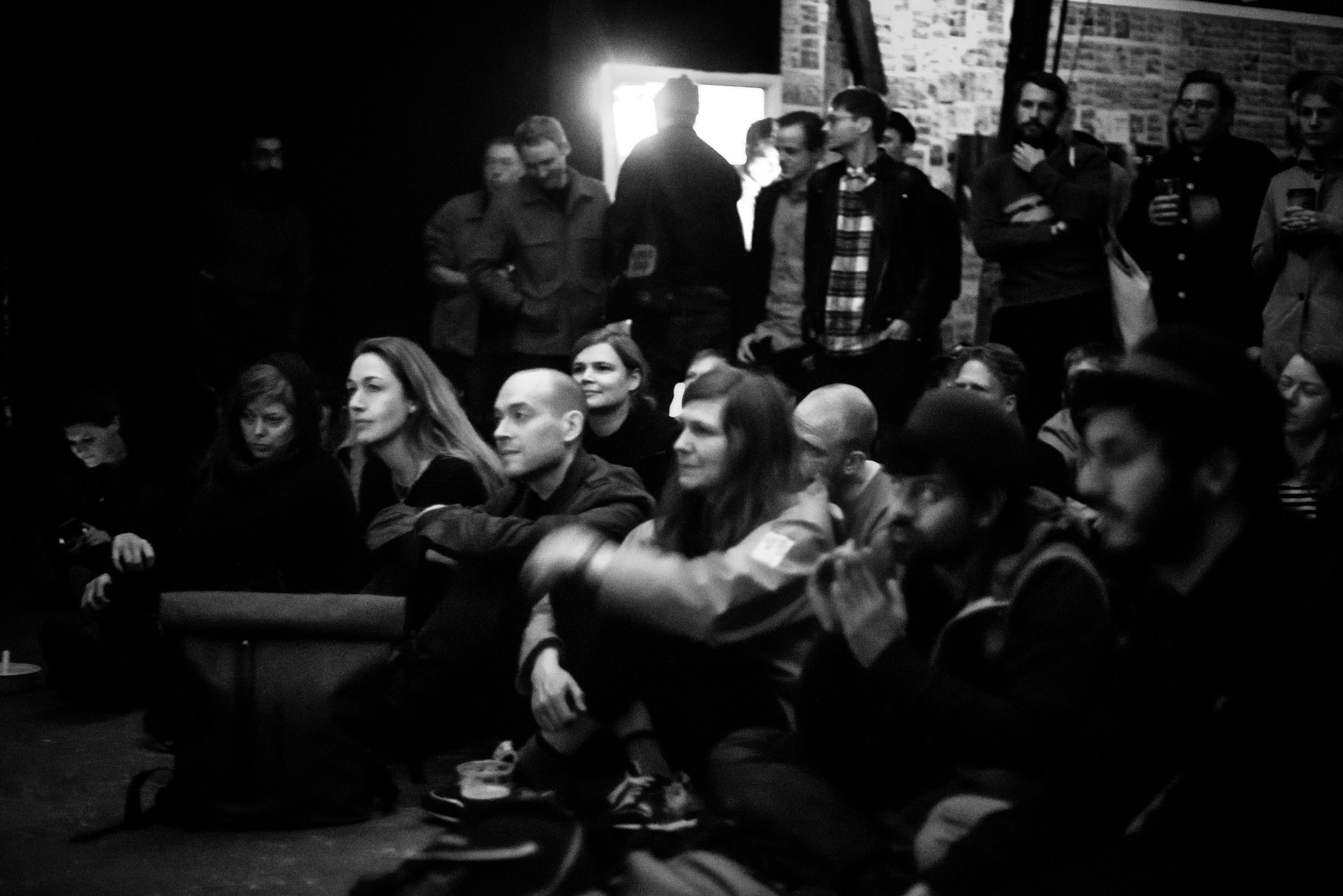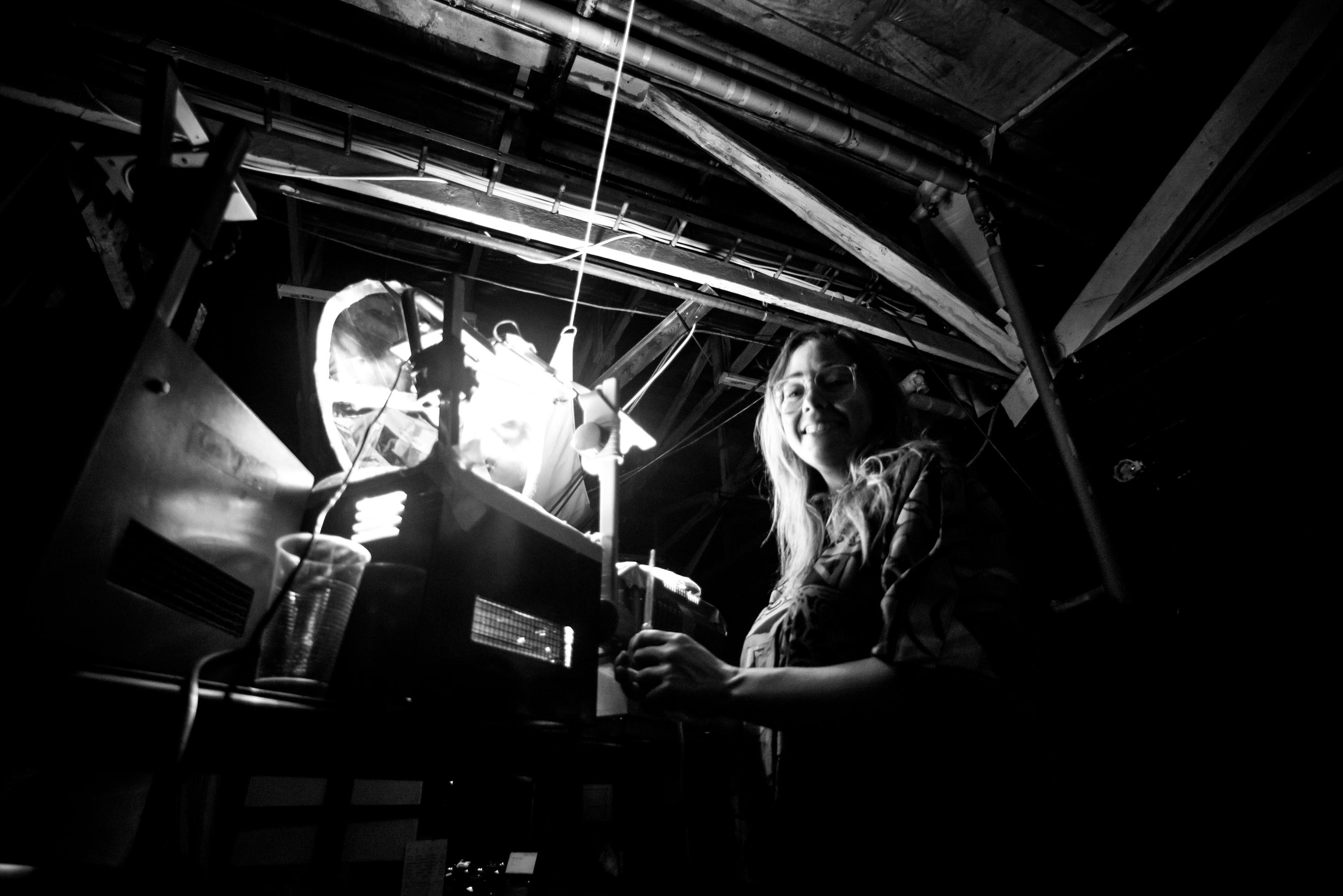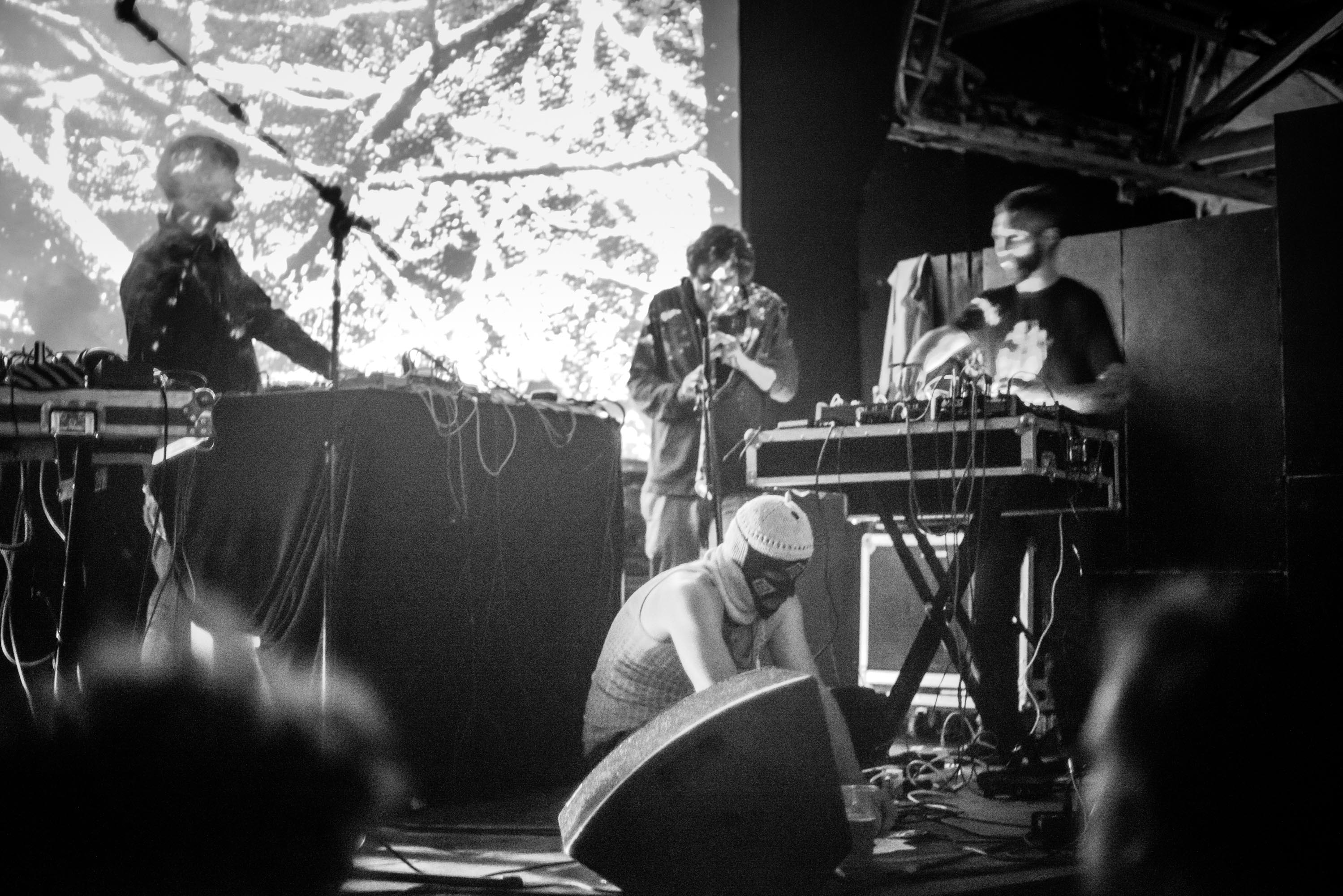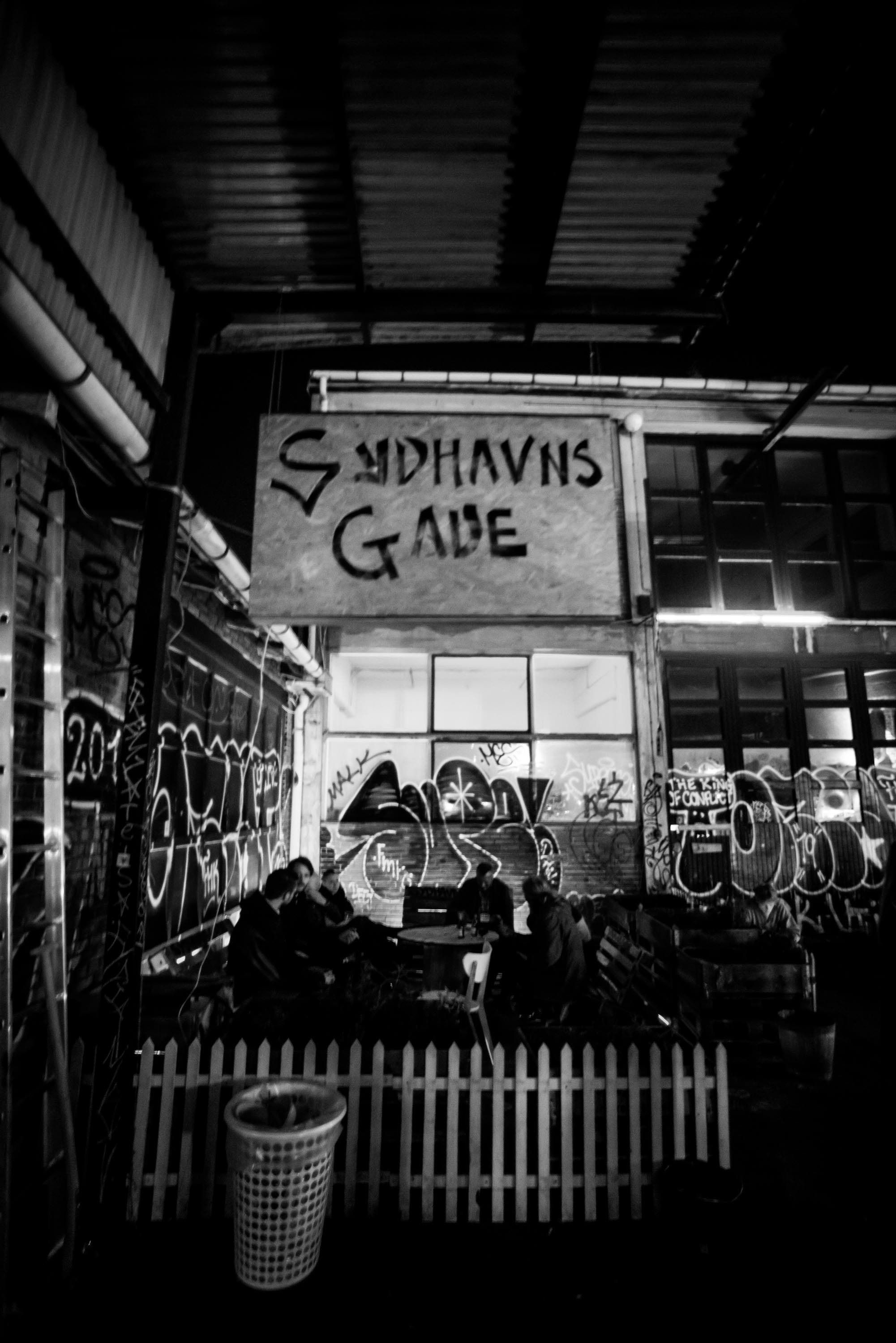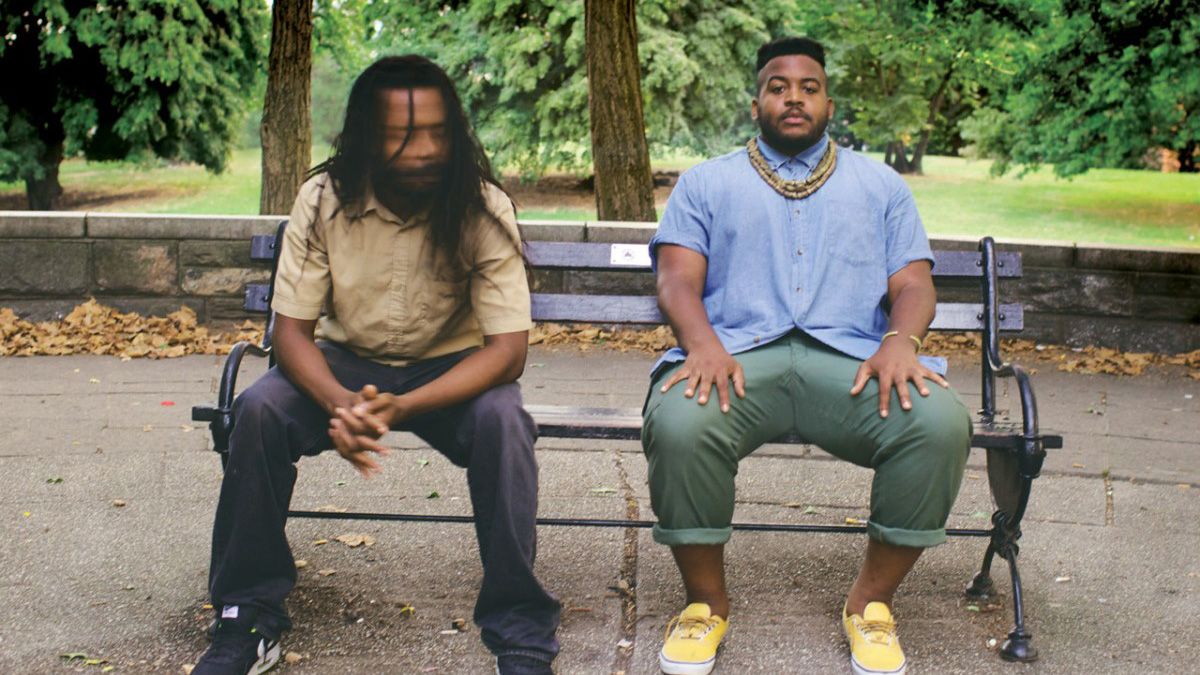Festival of Endless Gratitude 2017 – Sketching the outer edges of sound (reportage)
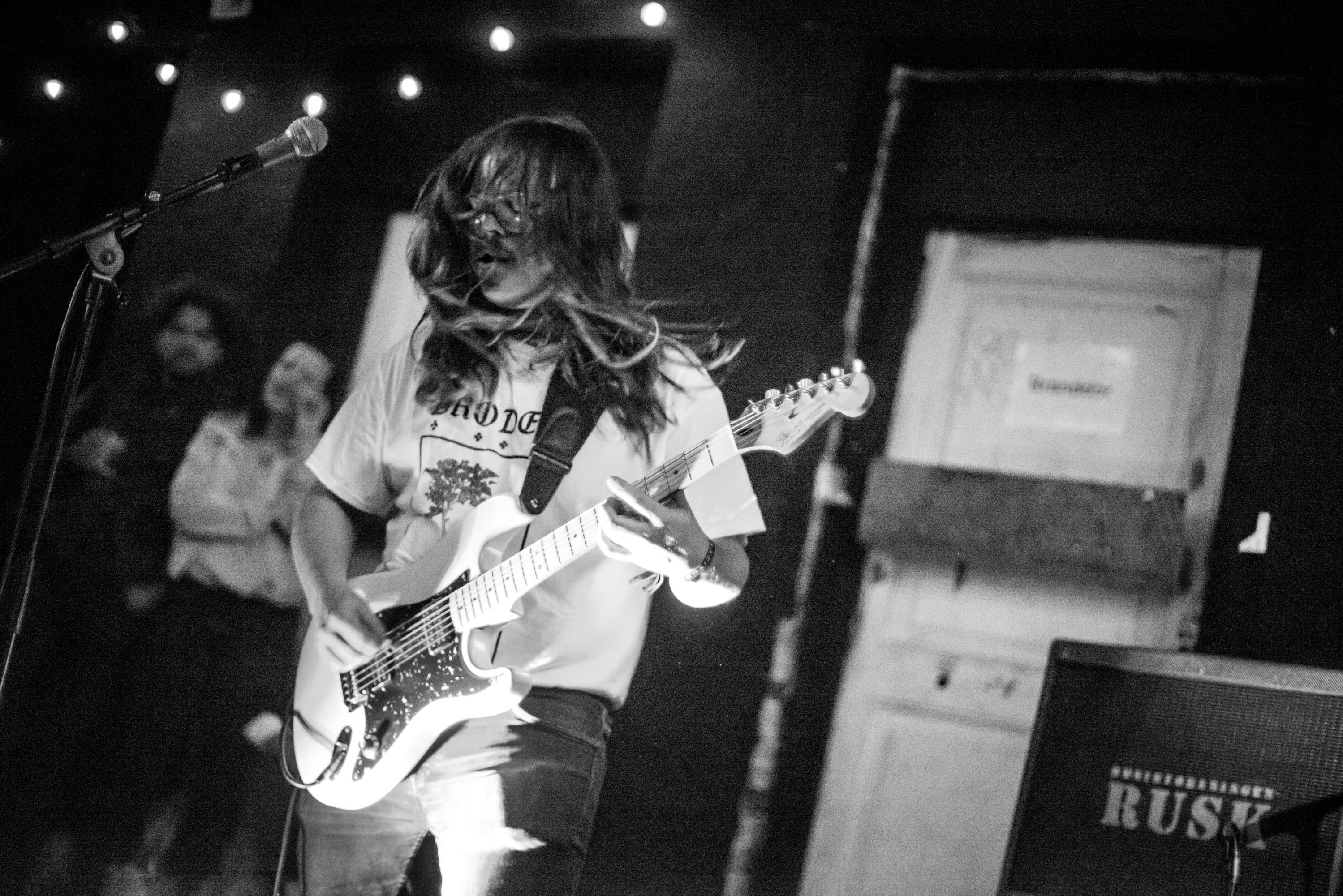
Festival of Endless Gratitude 2017, Sydhavnsgade, September 29-October 1. Reportage by Javier Orozco – photos by Stefan Thorndahl, videos by Morten Sichlau Bruun.
The chant of ‘Gabestok! Gabestok!’ pervaded the air anticipating the Copenhagen-duo’s ground level performance. As soon as their sonic assault was unleashed, the choir became all fists and mosh pit. Those of us who stepped out of the rumble still felt the local duo’s menacing short set, underneath the building’s wooden structure and amongst the art installations these moments screamed punk as fuck. Minutes later British experimental-duo Gnod’s divisive and largely improvised performance was well worth a what-the-fuck. These performances separated merely by minutes could not have been more different from each other. And this was only halfway into the second night of the 10th edition of Festival of Endless Gratitude.
Over the course of the last years this annual festival has created a cross-disciplinary space that gathers art-installations, analogue projections, film, performances and chiefly music (with a vigorous focus on sonic expansion and diversity); simultaneously it has provided a platform for experimental and underground local bands, while offering rare performances by international cult acts (Faust, RP Boo, Arpanet). Along with its determined aesthetic selection the festival has kept a devoted DIY spirit which is tangible in different facets of its personality: the active audio engineers, the food and drinks, and the way the premises are appropriated. At the core FoEG feels as the love-child of music enthusiasts with an ear for the peripheral and the uncharted; at its best one feels like crashing a large party of music enthusiasts.
This year’s edition marked a change of venue, the festival moved from KBH Volume to a location further down the street, a DIY-space soberly known as SydhavnsGade. From my perspective the move did not impact the atmosphere of the festival, since the organizers successfully transplanted the character and identity that the festival has cultivated throughout the previous years: the dreamy live projections, the installations (two of them located inside two intimate rooms) and the comfortable corners with improvised furniture were there. The location was entirely inhabited by FoEG.
Once again Festival of Endless Gratitude achieved to present a relevant selection of live music that was fueled by the energy of friendship and collaboration. Below is a rundown of the performances I caught during the three day festival.
Thursday
As I arrived Kim Myhr was releasing the last notes of his 12-string guitar and pedalboard. Across the room an atmosphere of anticipation swelled, while the breaks between acts served as a social melting pot, most of the present people headed either to the bar for a refill or outside for conversation. There was a floating expectation about the performance to be given by the Finnish outsider Pekka Airaksinen. He advanced floaty ambient compositions, successions of sounds that lingered and requested from the listener to stretch within them. Improvisation was the compass of his performance, yet there were fragments where the pieces did not fall into place.
Irrelevantbitch 101 was clearly the most polarizing act of the evening. The young local songwriter (and his backing) kicked-off his show with a pair of attention grabbing pop tunes and a self assured attitude. His blend of genres (r&b swagger, pop, and indie sensibility) almost catalyzed as the inaugural party-oriented moment of the festival, yet the charmed waned after the first part of the set as he stepped into melodic platitudes and youthful indulgence. A group of people danced devotedly during the set, yet a numerous part of the audience left the scene.
The following set, by the hands of Jonas Frederiksen (formerly of Girlseeker), who just recently returned to the Copenhagen music scene after a few years of hiatus, explored the intersection of techno and ambient. His music was both bassy and pensive, long sonic drifts that were occasionally punctuated by beats that took cues from slow-downed hip-hop and dub, the language was directed more towards the head than the feet. The night was sealed by DJ Marius Onofrei, he presented occult danceable gems direct from wax, a large amount of attendants had left by that time yet a small group of people chose to take over the dance floor.
Friday
I arrived as Norberto Lobo (a friend and longtime favorite among the ‘gratitude’-booking group) tuned his guitar, the sole instrument to be played during a performance that drew from sources of folk and primitivism. The initial plucking reflected his talent, yet he never seemed completely relaxed as his guitar requested tuning adjustments between his pieces, however, in spite of the instrument’s idiosyncratic behavior, a peaceful beauty arose creating a hallway where John Fahey could greet Portugal’s traditional fado.
After the break Duo PuechGourdon sculpted an array of trance inducing moments via a distant musical vocabulary that grabbed its lexicon from folk, drones and repetition. They employed a hurdy-gurdy, a cabrette, as well as stompting and chants, resources that though traditional are unusual. At its most intense it reminded me of Swans (circa “The Seer”) as if stripped down to their most basic elements and played through the mentioned instruments. One of the festival highlights.
Kali Malone presented long compositions that pushed our focus between drift and concentration, as a sporadic deep bass pattern unfurled which kept pulling our attention back. She presented a solid set without stepping into groundbreaking territory. Soon after her show, the local duo Gabestok (installed next to the scene) delivered a savage blend of punk and metal via menacing drum skills, aggressive vocals and a fuzzed out guitar. A small group of “fans” intoxicatedly moshed and screamed-along to their short and urgent songs. Their loud repertoire oozed a raw energy that caught the audience’s ears, no one left untouched. This performance encompassed many of the festival’s attributes: it offered a stage for a local underground band who delivered a brutal performance to an audience that may have not heard of them before.
(to be continued below the pictures)
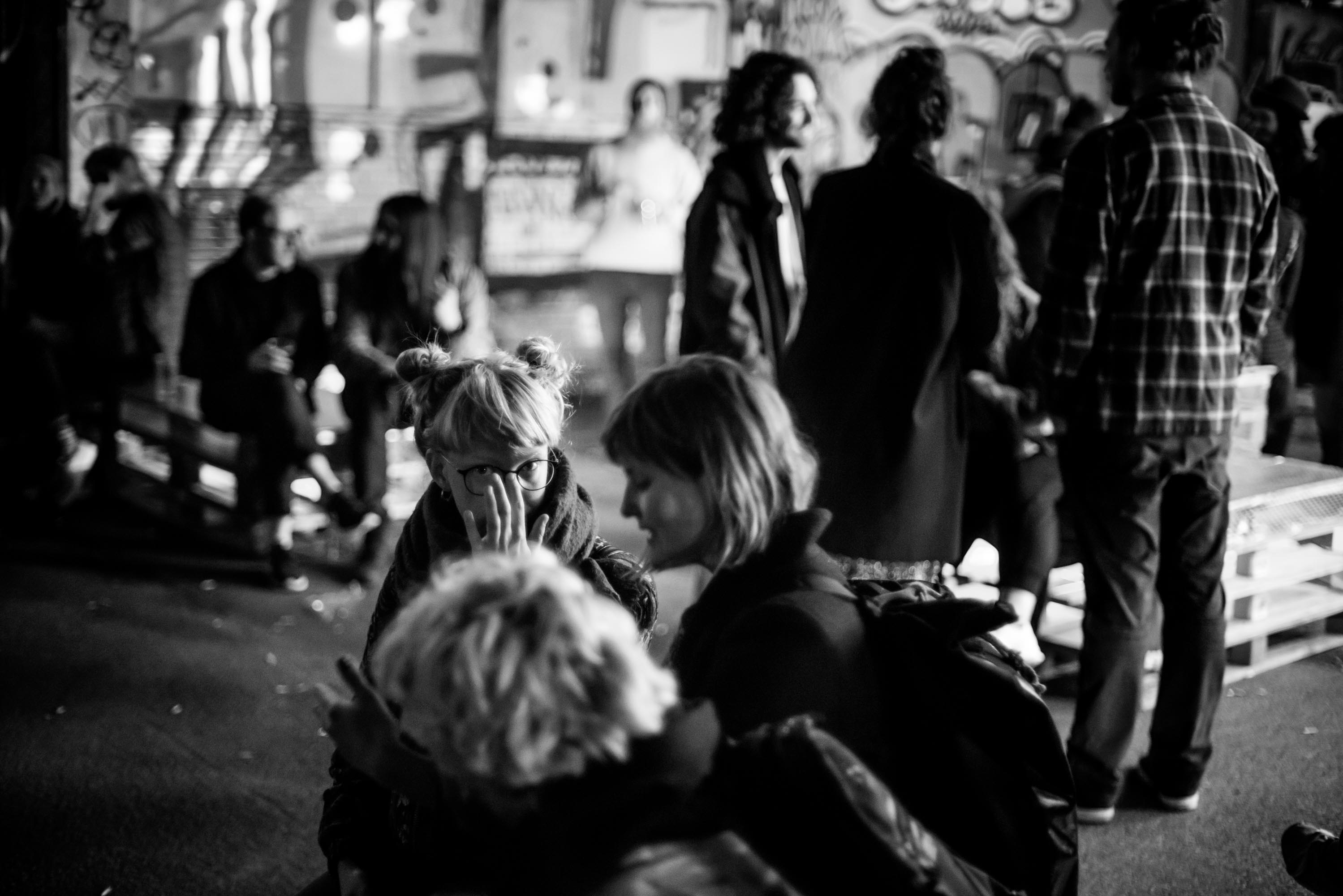
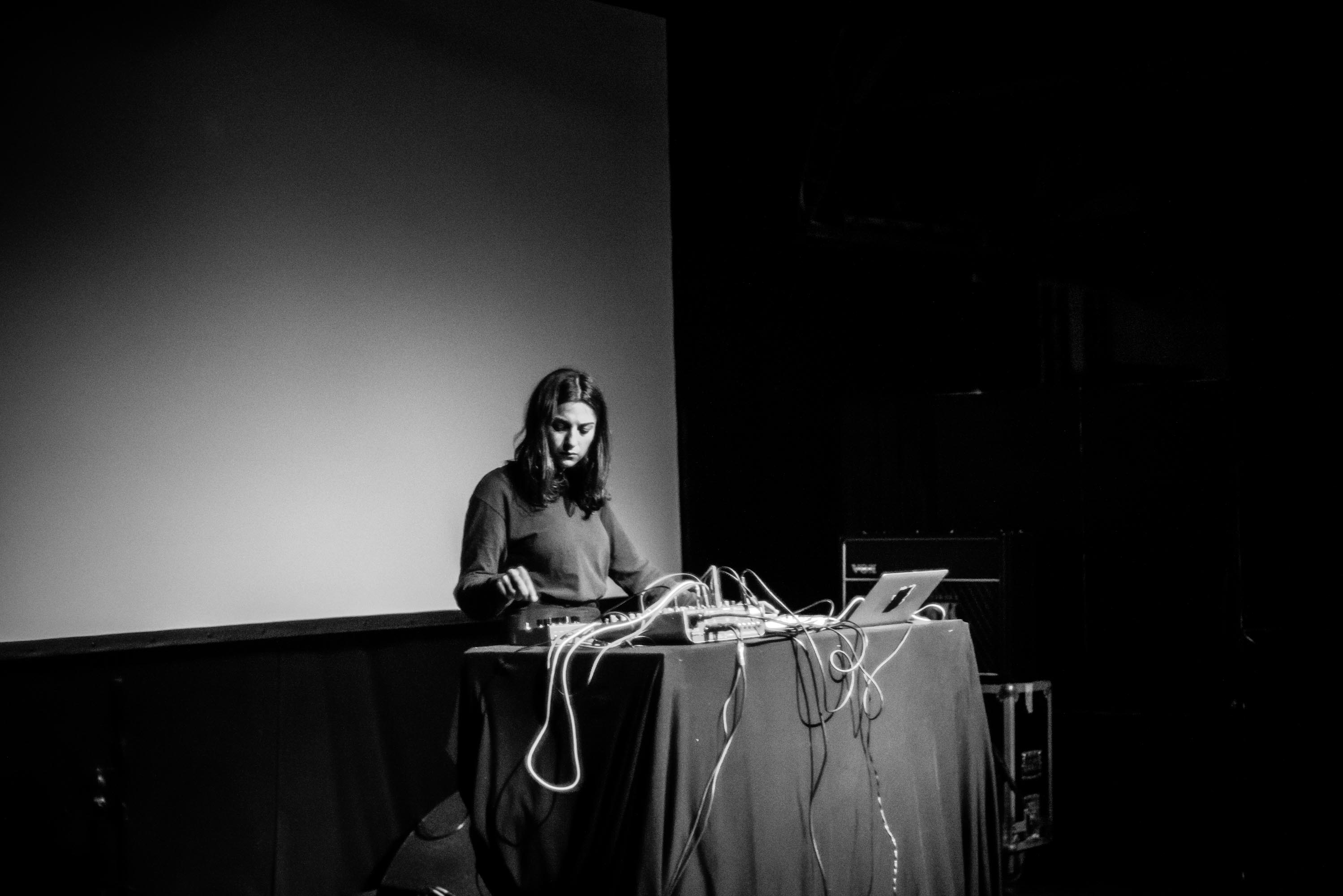
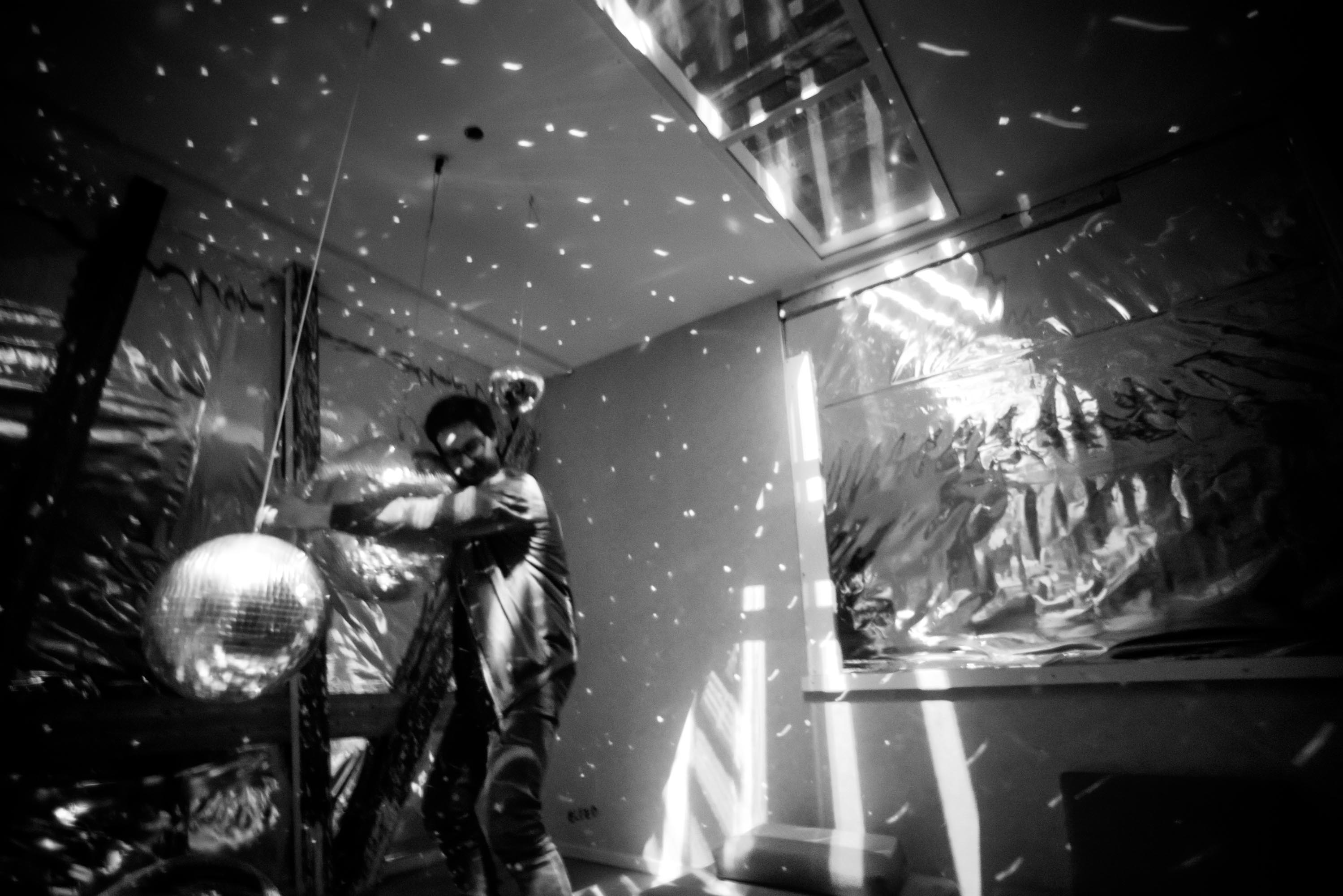
How to describe Gnod’s confounding show? The suspected elements were present: drone, noise, improvisation, provocation and psychedelic visuals, yet their performance did not meet the expectations. In spite of their elaborate display of experimentation and playfulness, it seemed as if they were performing exclusively for themselves, never opening a gateway for the audience to join. It was surely the festival’s most divisive show and to some extent a disappointment, a large part of the audience walked away halfway through their set. I stood there dumbfounded, not always in the good way.
Whatever confusion was left by Gnod it was scrambled up further by the live set of HVAD’s masterly cross-genre, knowledgeable and powerful beat selection which drew from a palette that cruised skillfully through techno, hip-hop, jungle, drum n’ bass, ethnic obscurities and what not (he might have even sampled a riff from Big Star). It was a dense and danceable canalization of the global village. Feet were restless.
Saturday
I arrived during French instrument maker Pierre Bastian’s performance, an intriguing assemblage of machinistic compositions. There is a sense of marvel that oozes from his shows, a childlike ‘how does he do it?’ that swirls across the audience. Meccanos, trumpets, and visuals that incorporate his shadow: his act felt complete and embracing. Next up was Peter Zummo, along with his trombone and a backing band comprised of the local musicians Emil Elg, Greta Eacott and Simon Latz. The performance moved seamlessly from hushed abstract compositions to pieces that incorporated rhythmic baselines and crafted a late night jazz vibe. Stripped down and at points minimalistic, the pieces were demanding but also captivating.
After the pause Crème de Hassan created an environment that galloped towards saturation. The visuals were an essential complement to a performance that composed of tribal percussions samples, improvised electronics, guitar drone, and reverb ridden flute loops. The musicians passed a joint back and forth, for a set that surely demanded one. At its zenith the performance was enthralling and embracing, yet certain passages felt less inspired. Crème de Hassan is a collaborative effort by Ghazi Barakat (Pharoah Chromium) and Paul LaBrecque from Sunburned Hand of the Man, the New England-collective who played a big part in the formation of the first Festival of Endless Gratitude 10 years ago.
The upcoming performance immediately pushed me towards the bar in search of a pair of free ear plugs, it was surely the loudest of the festival and also one of the most rewarding: Jung An Tagen stood at ground level with a minimal set up: a laptop and a controller. The first minutes swirled through an abstract high-pitched soundscape which slowly unfurled into an intricate version of a danceable language, a conjunction of frantic beats and zero-gravity aural patterns. With the visual side stripped to its bare components the audience was forced to plunge (and dance) into the meticulous and riveting sonic labyrinths carved by the Austrian producer.
STILL aka Hundebiss Records-boss Simone Trabucchi was the festival’s last musician to perform. A large part of the audience had departed by that time, however those who stayed were treated to a dubby set that moved eloquently from dancehall to futuristic reggeaton. He was joined by a vocalist/dancer that channeled the sexuality of these rhythms with his ornate hip movements while the audience made an honest effort to keep up with him. The set was immediate, tactile and physical. The audience dismantled without haste, some remained for the last DJ set of the weekend while small groups veered towards the exit.
Conclusion
An encompassing statement of the festival could point out that the music presented was challenging and dense yet decisively rewarding. This is only one amongst several reasons that cement the festival (10 years after its first edition) as a relevant and indispensable musical event in Copenhagen. ‘Gratitude’ offers three days of unusual sonic explorations in a non-intimidating setting: the festival never comes across as too-smart or deliberately tries to alienate its audience, instead it offers a point of convergence for those audiophiles who are eager to engage in exploratory live performances, those who attend due to an specific act and the casual visitors. However this is not achieved by way of a sacrifice, the aesthetic position of the festival is not mutilated as it somehow manages to reinvigorate itself year after year. The line-up followed the tradition of the festival’s previous incarnations: a blend of local and international underground acts that drifted towards the outer edges of several experimental genres, and a smaller number of acts that presented a more a straightforward take on music making. The selection was eclectic: twelve different nationalities were represented amongst the performers with genres as diverse as their passports.
For all the virtues one may list about FoEG there were certain holes within this year’s program. From an exclusively personal perspective I feel that this edition lacked a strong name (such as Roedelius or Charlemagne Palestine in previous incarnations). This is not due to a blind assumption that a left of the dial music festival should boast a “big” name, yet there is a certain allure in having the opportunity of witnessing a live performance by a prominent and legendary act, which may also operate as a magnet that enhances the diversity of the crowd, hence generating exposure for lesser known acts: as it could have happened in 2014, say that someone showed up for Faust but discovered and praised a young danish band like Narcosatanicos. Another issue that I detected was a meager presence of female artists across the lineup (I counted two this year); for a festival that is known for its defiant selection of performers it would only make sense to incorporate the current debates about the intersection of femininity, minority and art into its program.
All things considered Festival of Endless Gratitude feels necessary within Copenhagen’s musical landscape, not only as a part of it, but as an agent that plays a role in creating and shaping the local scene.
